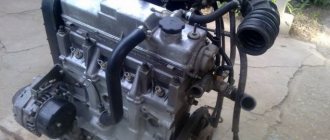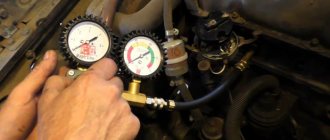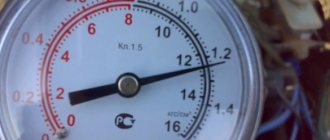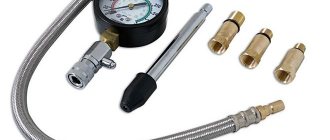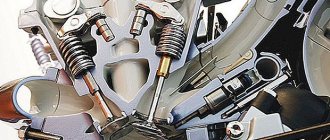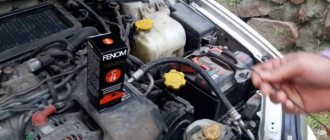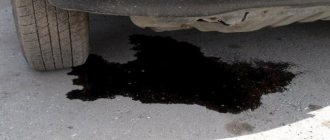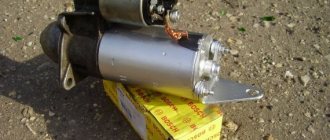What is compression and how is it measured?
Compression is the amount of maximum pressure created in the cylinder when the piston moves from bottom dead center (BDC) to top dead center (TDC), when the engine is idling with the starter. The concept of “compression” should not be confused with the concept of “compression ratio”, which is a calculated value and denotes the ratio of the volume of the piston space above the cylinder when the piston is at bottom dead center (BDC) (full volume of the cylinder) to the volume of the space above the cylinder when the piston is at the top. dead point (TDC), that is, to the volume of the combustion chamber. Compression testing is one of the simplest and most accessible ways to diagnose an engine. The apparent simplicity of the procedure for measuring compression has gained fame as a kind of “universal” method, capable of not only identifying a malfunction, but also generally assessing the technical condition of the engine as a whole. But this universality is deceptive - the obtained measurement results often require special analysis, and it is not always correct to draw unambiguous conclusions from them, since the pressure in the cylinder at the end of the compression stroke, when the piston is at top dead center (TDC), depends on a number of factors.
How do you check engine compression?
The most common device for these purposes, which will help determine has the compression dropped in the engines - compression gauge. This device is a pressure gauge connected by a hose to a fitting and a check valve. As the engine crankshaft rotates, air is forced into the hose until the pressure in the hose equals the maximum pressure in the cylinder. Its value will be recorded by a pressure gauge. Unlike simple domestic designs, foreign analogues are produced with sets of adapters (adapters) that allow measurements to be taken on cars of any make and model. Compressographs are also easy to use. Their purpose is the same, but the measurement results are recorded on paper or special plastic cards, which makes it possible to archive them for subsequent comparison at different periods of vehicle operation. The disadvantage of the compressor is the difficulty of assessing the dynamics of pressure increase when cranking the crankshaft.Modern motor testers quickly and efficiently measure compression. These devices actually record not the pressure, but the amplitude of the pulsation of the electric current consumed by the starter during cranking - the higher the pressure in the cylinder, the greater the expenditure of starter power to rotate the crankshaft. Thereby, if the engine compression has dropped, it is possible to simultaneously measure the compression in all cylinders in just a few revolutions, without resorting to turning out the spark plugs, which is important for multi-cylinder engines. The disadvantage of a motor tester is that the results obtained are expressed in relative units, for example, as a percentage of the cylinder that works better. Only the most expensive engine testers are capable of measuring the absolute value of compression in each cylinder, but this is only possible on the basis of a large number of statistical data for a specific engine model and their comparison with the actual pressure in the cylinder.
Compression recovery
There are several ways to restore compression in an engine, and all of them are effective when it is slightly reduced from normal, and only if there is no mechanical damage to the cylinder-piston group.
Grandfather methods
If the diagnosis reveals that the decrease in pressure is associated with the presence of rings, then you can raise it without resorting to expensive means, here are a couple.
- Quite an effective way. We take equal parts: kerosene, acetone and pure oil. Mix, pour 50 ml into the cylinders and screw in the candles. Let it sit for about ten hours. Unscrew the spark plugs and turn the engine for a few seconds. We put the spark plugs in place, start and warm up the engine to no more than 40°C. We flush the system and change the oil.
- An easier way. Pour one hundred grams of clean oil into each cylinder and periodically turn the crankshaft a little in one direction or another. Repeat if necessary.
Special means
If you don’t trust folk remedies or they didn’t help, then you can find special products on sale, both imported and domestic. They can not only de-coke the deposited rings, but also completely clean the combustion chamber, clear deposits on the operating chamfer plates of the valves, both intake and exhaust.
However, please note that some products may be difficult to use or may require advanced skills. All this is usually described in the instructions
Additives
Various additives (another name for tribocomposition) used to increase engine compression are also an effective means
It is important only to purchase products from trusted or well-known manufacturers. Of course, there are fewer fakes now, but they still exist
Various additives are used for diesel and gasoline engines.
Using additives is the easiest way; just pour them into the engine. Over time, this leads to a positive result if there are no other reasons for poor compression, such as stuck rings.
The active substances added to the additive are deposited on the rubbing surfaces, leveling them and reducing friction, and the reduced friction reduces engine noise. Compression in the cylinders is leveled out and increased, and as a result, power.
There are a lot of manufacturers of such additives, and the most famous are: Liqui Moly (CeraTec additive), Suprotec (Suprotec Active Plus composition) and others. The rating of the tested tribotechnical compounds was carried out on the Za Rulem website.
https://youtube.com/watch?v=_iFdDrfLobY
Source
What affects engine compression?
First of all, we note the position of the throttle valve: the more it is open, the more air entering the cylinder, the higher the compression and vice versa - a closed valve will reduce the pressure in the cylinder. Naturally, the amount of air entering the cylinder is also affected by the degree of contamination of the air filter. Compression is also affected by irregular valve timing , for example, during installation or as a result of jumping of the camshaft drive belt or chain. This leads to a change in the closing moment of the intake valve, shifting the beginning of compression in the cylinder to one side or another. Then the compression values will be different. The clearances in the valve drive (in the absence of hydraulic compensators or when they are faulty) have a rather strong effect on compression.
So a small gap in the intake valve drive will lead to their closing later and, accordingly, to a decrease in compression. At the same time, small clearances in the exhaust valves will increase the so-called valve overlap - the amount of crankshaft rotation angle during which both valves in the cylinder are open simultaneously. The result is the same - compression will decrease. The engine temperature will also affect compression - the lower it is, the more the air compressed in the cylinder will be cooled, and the lower its pressure will be. The engine temperature affects the thermal clearances in the valve actuator, which in turn affects the measurement results. But that's not all. Malfunctions of fuel equipment; oil entering the combustion chamber through valve guides, piston rings, crankcase ventilation system and turbocharger seals; The degree of charge of the battery and a malfunction of the starter can affect the amount of compression. As is clear from the above, if your engine has lost compression in one cylinder, two cylinders or 4 cylinders, there may be several reasons.
| How to diagnose the engine yourself, read our article: “Do-it-yourself car engine diagnostics” “...It is impossible to insure for all eventualities, but it is possible to reduce the likelihood of such a problem, for example, with an engine. To do this, you need to learn how to assess the technical condition of the engine or diagnose it. This is especially true after winter cold and sudden changes in the temperature of the surrounding atmosphere. Diagnosing a car engine with our own hands will help us understand what kind of repair work we may encounter in the warm season..." Go to article... |
How to check engine compression correctly?
If we take into account all the factors listed above, then when measuring compression the following simple rules must be followed:
- the engine must be “warm” “warm up”;
- the fuel supply must be turned off (you can turn off the fuel pump, injectors, or use other methods to prevent fuel from entering the cylinders);
- on gasoline engines, it is necessary to remove all spark plugs (selective removal of spark plugs is unacceptable, as it increases the rotational resistance and arbitrarily reduces the speed when the engine is cranked with the starter);
- The battery must be fully charged and the starter is working properly.
Compression is measured with both the throttle valve open and closed. Moreover, each method gives its own results and allows you to identify its own defects. So, when the damper is closed, little air will enter the cylinders, the compression will be low and will be about 0.6-0.8 MPa. Air leaks in this case are comparable to its entry into the cylinder. As a result, compression becomes especially sensitive to leaks - even with small leaks, its value drops several times. This measurement allows us to draw conclusions or assumptions about the following engine defects:
- about unsatisfactory fit of the valve to the seat;
- about valve freezing, for example, due to improper assembly of the mechanism with hydraulic pushers;
- about defects in the camshaft cam profile in designs with hydraulic lifters, including uneven wear or runout of the back side of the cam
- about a lack of tightness caused by a burnout of the head gasket or a crack in the wall of the combustion chamber (these defects are accompanied by white smoke, the formation of an emulsion in the oil, and increased pressure in the cooling system)
When measuring compression with the throttle open, the picture will be different. A large amount of incoming air and an increase in pressure in the cylinder contribute to an increase in leaks. But the compression does not drop so significantly (to approximately 0.8 - 0.9 MPa). Therefore, the measurement method with an open throttle is better suited for determining more “severe” engine defects, such as;
- breakdowns and burnouts of pistons:
- breakage or freezing (coking) of rings in the piston grooves;
- deformations or burnouts of valves:
- serious damage (scoring) to the cylinder surface:
In both measurement methods, it is advisable to take into account the dynamics of pressure growth - this will help to establish the true reason why the compression in the engine has dropped with greater probability. So, if at the first compression stroke the pressure measured by a compression meter is low (0.3-0.4 MPa), and during subsequent strokes it increases sharply, this indirectly indicates wear of the piston rings. In this case, pouring a small amount of oil into the cylinder (3 - 5 cc) will immediately increase the pressure on the first stroke and the compression in general. On the other hand, when on the first stroke the pressure reaches 0.7-0.9 MPa, and on subsequent strokes it almost does not increase, most likely there is a leak in the valve or head gasket. To more accurately establish the cause, it is necessary to use other diagnostic tools or indirect signs.
How to use measurement results in practice?
The basic rule to remember: in most cases, the results of compression measurements are relative. This means that, first of all, it is necessary to rely on the difference in compression values of different cylinders, and not on its absolute value itself. Here are just two examples that confirm the validity of this statement. A relatively new engine cannot be started. The compression in the engine has dropped. Compression in the cylinders is 0.5 - 0.6 MPa (5 - 6 kg/cm2), which is approximately half the norm. The reasons may be mechanical failure or wear of parts of the cylinder-piston group. But the same drop in compression can be observed due to a malfunction of the fuel supply system. Excess fuel enters the cylinders, it washes away the oil from the cylinder walls, and the piston rings no longer properly seal the combustion chamber cavity. Another case: in an old engine the compression is 1.1 - 1.2 MPa. Norm! However, the engine consumes more than 1 liter of oil per 1000 km. This is understandable if you take into account the wear of rings, pistons and cylinders. What's the matter? The answer is simple, a large amount of oil penetrating into the combustion chamber seals the gaps in wear areas. As we can see, the measurement results should be treated with caution. And, in order not to make mistakes in your conclusions during repairs, you should know in which cases you can confidently rely on the measurement results, and when you can only take note. Table 1 contains a list of faults and data from some compression measurements, if any. Of course, this data does not have specific meanings, but will only make it somewhat easier to determine the direction of troubleshooting. Table 1. Some defects and malfunctions of gasoline engines identified by compression measurements
| Malfunction | Symptoms of a problem | Compression, MPa | |
| open damper | closed damper | ||
| Fully working engine | None | 1,0-1,2 | 0,6-0,8 |
| Crack in the piston bridge | Blue exhaust smoke, high crankcase pressure | 0,6-0,8 | 0,3-0,4 |
| Piston burnout | The same, the cylinder does not work at low speeds | 0,5-0,5 | 0-0,1 |
| Occurrence of rings in piston grooves | Same | 0,2-0,4 | 0-0,2 |
| Piston and cylinder scuffing | The same, unstable operation of the cylinder at idle is possible | 0,2-0,8 | 0,1-0,5 |
| Valve deformation | The cylinder does not work at low speeds | 0,3-0,7 | 0-0,2 |
| Valve burnout | Same | 0,1-0,4 | 0 |
| Defective camshaft cam profile (for designs with hydraulic tappets). | Same | 0,7-0,8 | 0,1-0,3 |
| Increased carbon deposits in the combustion chamber in combination with worn valve stem seals and rings | Increased oil consumption with blue exhaust smoke | 1,2-1,5 | 0,9-1,2 |
| Increased wear of the cylinder-piston group | Increased fuel and oil consumption due to waste | 0,2-0,4 | 0,6-0,8 |
Metal conditioners
Metal conditioners are additives that contain chloroparaffin compounds, mainly chlorine and sulfur. Operating principle: dissolve wear products - metals, transforming them into salts. These salts enter the friction zone, where they are again deposited, possibly releasing pure metal. However, the carrier of active chlorine in metal conditioners is chlorinated paraffins, i.e. polymers. In addition, they also contain fluorinated polyesters - extreme pressure components, carriers of pure fluorine. Therefore, in parallel with the implementation of a closed wear-recovery cycle, partial polymer cladding of friction surfaces with paraffins and polyesters occurs. But the presence of polymers in preparations increases their tendency to form deposits in the combustion chamber. To compensate for this negative phenomenon, a combination of alcohols and ethers was introduced into the air conditioners, playing the role of cleaners and counteracting the process of carbon deposits.
Pros:
- sharp decrease in friction coefficient
- the presence of free fluorine in the oil suggests the presence of another protection mechanism - partial epilation of the surface
Minuses:
- chlorine-containing substances are highly toxic, therefore the use of drugs in this group is limited in the USA and Western European countries;
- paraffin-containing substances are unstable to high temperatures and decompose in the engine combustion chamber;
- To work effectively, the drug must be constantly present in the oil.
Well-known manufacturers: Hado, SMT2, ER, Fenom, Hi-Gear.
The compression in the engine has dropped - will SUPROTEC compounds increase the compression in my engine?
So, we know what compression is, how to measure it correctly and how it can be measured, we know the factors influencing the measurement results, and now we can talk about the possibility of partial or complete restoration of compression using the SUPROTEC lubricant composition.
The SUPROTEC lubricant composition is not an additive or additive to the lubricant, since it does not improve its characteristics, but interacts directly with the metal surfaces of the contact zones (friction surfaces) of parts of components and mechanisms.
SUPROTEC compositions help the “friction couple” system (for example, piston ring - liner, shaft journal - bearing liner, etc.) reach a new qualitative level of energy balance (more optimal contact conditions for friction parts), they act as a catalyst and initiate process of adaptation of the friction pair system. SUPROTEC compositions have the effect of restoring friction surfaces (forming a protective layer up to 15 microns thick) and the effect of optimizing the geometry of friction surfaces. In addition, the created metal structures (protective layers) have increased oil-retaining ability - the protective layer holds oil on the surface much stronger than a normal surface, which shifts the friction mode to the region of semi-fluid or hydrodynamic friction (the work of an “oil wedge”).
Engine oil additive "Suprotek Active Plus"
Restores compression, reduces fuel consumption and oil waste, reduces wear rate and extends the life of internal combustion engines of any type. Facilitates cold starts and protects against overheating in traffic jams.
more reviews
Figure 1 shows all the parts and mechanisms of the engine that are directly related to the amount of compression; all of them are, to one degree or another, subject to friction processes, and accordingly, SUPROTEC compositions can have an effect on them (only the cylinder liner is not shown).
Rice. 1
Friction parts of such units as the cylinder-piston group, crank mechanism, gas distribution mechanism primarily determine the condition and service life of the engine, and, in addition, are the most expensive spare parts.
During normal operation of the engine, SUPROTEC compositions form a new structure layer by layer on the “base metal”, which is based on a crystal lattice of iron.
But this happens only in zones of direct contact of rubbing surfaces, and the load and temperatures in the contact zone must be significant.
Layered Friction Modifiers
Layered friction modifiers - the composition includes compounds of molybdenum, tungsten, tantalum, graphite, etc. The operating principle is to form a layered surface layer on the friction surfaces with a low shear force and, therefore, a low coefficient of friction.
The disadvantages are so great that we will skip the pros:
- the friction reduction effect is not sustainable;
- the coating is not durable, and a decrease in the concentration of the drug in the oil quickly negates the effect of the treatment;
- high rate of decomposition of sulfur compounds at high temperatures, which increases the corrosive activity of engine exhaust gases;
- graphite, which is part of some drugs in this group, has a tendency to deposit in piston grooves, oil channels and on valves, which, with prolonged use of the drug, leads to the closing of the gaps in the piston rings and their occurrence, or the valves “hanging” in the guide bushings.
Well-known manufacturers: Xenum, Liqui Moly.
